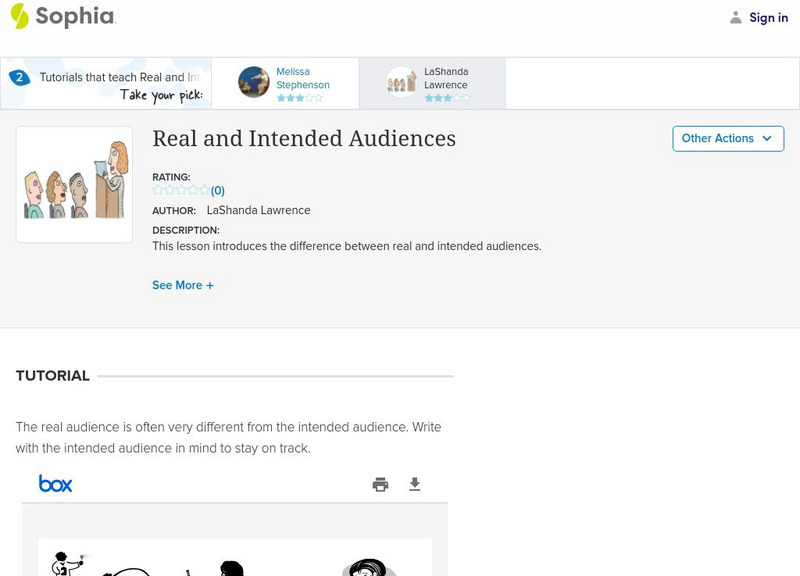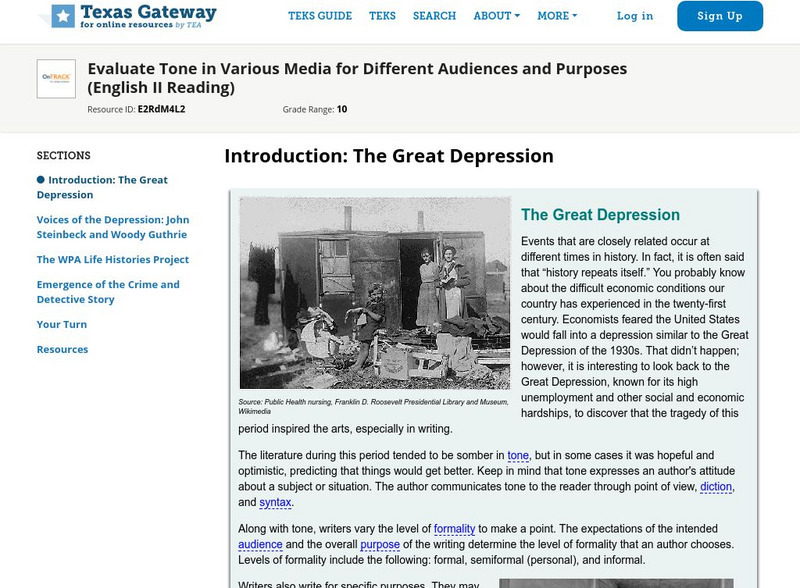Curated OER
Determining the Form of Representation for Presenting Research
Students make appropriate choices regarding the form of representation for presenting their research projects, taking into consideration six questions before making decisions.
Curated OER
Cultural Symbols are Cool
Fifth graders recognize pioneer symbols and create a personal symbol. They, in groups, each get a state symbol and have them discuss why that symbol represents Utah. Have the groups select a spokesperson to share group findings with the...
Curated OER
Predictions, Predictions, and More Predictions
Third graders pose questions about the subject of a short story based on the title and cover illustration; then read the story and determine if their questions actually pertained to the story line, and, if so, how the story answered the...
Curated OER
Discovering Democracy in Canada: Federal Perspectives
Tenth graders research one aspect of government. They teach their peers co-operatively about the key elements of Democracy in Canada at the Federal Level by giving group presentations.
Curated OER
Canada's Immigration Policy: Mock Immigration Hearing
Students explore the Canadian immigration process, and assuming the roles of immigrants from varied backgrounds, and take part in mock immigration hearings.
Curated OER
Creating Professional Awareness: What I Discovered At The Teachers' Institute On Canadian Parliamentary Democracy
Students do research about the Canadian government and become aware of all the resources available to them.
Curated OER
Survey Strategy
Students develop their research techniques and their ability to question and think critically about democracy and the parliamentary system of government.
Curated OER
AM to FM - Lesson 4
Young scholars examine different music styles played on AM radio versus FM radio. They compare a 1972 music hit from AM radio with a 1972 hit album on FM radio.
Curated OER
Small Group Acting: Enlivening Canadian History
Tenth graders research the elements of Canadian identity and history. They analyze and organize the information. They investigate the concept of Small Group Acting, storyboarding, and writing a good script.
Curated OER
Pictorial Portfolio
Students develop a pictorial portfolio of important assignments, projects and activities through their high school years. They use a camera and decide what makes a good photograph. Students organize their photographs into a portfolio...
Curated OER
Diversity Issues in Teacher Education
Students send E-mail to a partner describing an experience related to their identity and abilities, culture, ethnicity, race, or religion. Partners then reflect their opinions about this experience back to their partner.
Curated OER
Let Me Convince You
Students discuss the purposes of persuasive speaking and writing with emphasis upon what makes them different from other kinds. They brainstorm and discuss ways to select "The Greatest American Who Ever Lived" and prepare a persuasive...
Curated OER
Cracking Catlins's Code
Students create a chart comparing visual clues with artistic meaning. This lesson plan is designed to introduce students to the ways in which consistent patterns of gesture and pose chosen by an artist (specifically George Catlin)...
Curated OER
Media Literacy Skills
Third graders watch a news story from three different networks in order to determine how the same story can be presented in three different ways. Next, working in small groups they create a newscast of a current event to share with the...
Curated OER
Mystery Box
Fourth graders engage in a icebreaker activity that is meant to introduce curriculum areas at the beginning of the school year. The teacher prepares several different boxes filled with items that are to be studied during the year. Then...
Curated OER
American Folktales
Fourth graders read and interpret an American Folktale. Students create their own folktale about Indiana. Students use digital cameras and clipart from the computer to create a photo story. Students present their animated folktales to...
Curated OER
Integrated Social Studies and Storytelling Lesson
Fourth graders study the Civil War. They examine online photos that are connected to Indiana's role in the Civil War. They choose one of these photos and in a story circle, tell a story about it. They tell who is in the picture, what...
Curated OER
Analyzing Free and Fair Elections
Students brainstorm the qualities of a "free and fair" elections. They read background information pertaining to the upcoming 2007 presidential elections. Pupils compare the "free and fair" elections list composed by students to the...
Curated OER
Client Profiles
Students in an interior design class read over pretend client profiles. In groups, they use the profiles to design a floor plan for their new house. To end the lesson, they present the floor plan to the class and ask for feedback on...
Curated OER
How's the Weather?
Learners explore earth science by researching the Internet. In this weather pattern lesson, students utilize the website weather.com to analyze the weather in different geographic locations. Learners view charts and graphs based on...
Curated OER
TE Activity: Testing the Caverns
Learners make model caverns out of paper mache or clay. They bury them in a tray of sand, and test the models by dropping balls into them simulating as asteroid hitting the earth. They discuss the results of the activity in a whole class...
Sophia Learning
Sophia: Real and Intended Audiences
This slideshow focuses on real and intended audiences including defining them, listing audience types, discussing the purpose of writing to an audience, and things to avoid.
Texas Education Agency
Texas Gateway: Evaluate Tone in Various Media for Audiences and Purposes
This lesson features several weather videos, both real and created, to help students understand how information and the tone changes based on the audiences and the purposes for the presentation.
Texas Education Agency
Texas Gateway: Evaluate Tone in Various Media for Audiences and Purposes
This lesson will help you evaluate changes in formality and tone within printed texts written for specific audiences and purposes. It focuses on writing produced during the Great Depression. RL.9-10.4 Word choice, Tone























